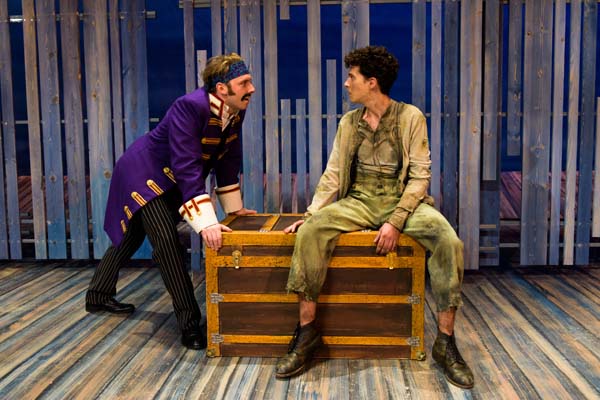SALT LAKE CITY — Occasionally, live theatre creates an unforgettable adventure. Even though it’s just minutes from h ome, Pioneer Theatre Company’s production of Peter and the Starcatcher creates a remarkable journey of the imagination, thanks to dedicated artists who bring out the most fun—but also the most difficult parts—of trying to not grow up.
Based on a book by Ridley Pearson and Dave Barry, and adapted for the stage by Rick Elice, Peter and the Starcatcher is a prequel to J. M. Barrie’s timeless tale of Peter Pan. It does veer from some of the stories that are explained in the original book and play, but it sets the stage for some the most important elements. This story starts with an orphan Boy who is heading on the boat, Never Land, to a far away country. The same boat has a young girl, Molly, and a mysterious trunk of great value. The Boy learns that the trunk contains starstuff that has great magical powers and that Molly is a Starcatcher, who tries to protect it. They end up on a collision course with the strangely familiar villainous pirate, Black Stache, who is also after the trunk, and by act two, end up marooned on an island.
Immediately on this voyage, I was absorbed in the unique form of storytelling. As all actors came on stage it is apparent some will have specific roles, but they can also be the narrator, and by simple change of costume props become someone else, or a door, or a boat, or well… anything else. These changes were faster than a shooting star, so it does require a considerable amount of attention from the audience. However, the direction by Jenn Thompson was tight and did an excellent job of pulling in familiar objects to create the scenes and characters. This occurred, for example, as Molly ventures across the ship the first time. She slid along a wall created by the other actors, but as she pushed one open like a door she saw scenes that varied from church choirs, to Guys and Dolls-style crap shoots, to the captain training his crew. The last one even tied in to the story later, showing the details considered in both the script and direction of these imaginative moments.
The script was quick, witty, and at times childish. I mostly bring this up as a matter of experiences from my fellow patrons. The script moved from one scene to another and one joke to the next plot point faster than a fencing duel. My wife noticed this as she occasionally heard the audience laughing, and she was left wondering what she missed. Although the script was based off a children’s story, the humor is a little more inappropriate than for a preschooler, but not quite to a sophisticated adult level. There were moments left open to local interpretations (“we’ll be big, think Hale Center Theater!”) and early on there were even a couple fart jokes and some mild sexual innuendos throughout. None of this seemed out of line for what was a uniquely told coming of age (or agelessness) tale. However, once the scrim painted with shell-clad mermaid raised after intermission, there were a couple of seats left vacant.
They missed out, because that opening ensemble piece of mermaids singing about “starstuff” was fantastic. The ensemble was essential to executing this show, and they worked together like a well-seasoned boat crew. No one member held the rest back, but some really left a mark. I particularly loved Oliver Wadsworth, who spent most his time as Betty Bumbrake. Wadsworth’s beautiful beats of alliteration blew the britches off the boatswain, Alf, and Betty’s nasal falsetto and ever-concerned air made her a highlight of the evening as Molly’s “Nana.” The well-tuned chemistry of the orphans, Prentiss and Tubby Ted (Austin Archer and Jake P. Evans), was very natural from the constant bickering about Prentiss’s leadership qualities to Tubby Ted’s fainting over pudding.
Boy and Molly rounded out the group of children, and the two were very clearly the leaders and crux of the story. Justine Salata gave Molly the appropriate amount of dogged determination and touch of naiveté the young woman required, making her fearless in her opinions and delightful in her exacerbations. She had the right attitude of condescension towards the orphans as she quickly displaced Prentiss as leader, the displeasure of not being quite old enough when dealing with her father and Nana’s expectations, and the intense curiosity in relation to this boy. The boy was definitely an interesting story. Contrary to Barrie’s retrospect explanations or Barry and Pearson’s unwilling leader, Boy had only the idea that he wants to be a boy for little while. His heroics were driven out of his insatiable curiosity regarding the starstuff and the starcatcher protecting it, Molly. Liam Forde brought all of this out as the nameless boy develops from sullen isolation to the anxious joy of finding his identity as the “boy who never grows old.”
One of those key times came when he faced Black Stache who proposed Boy join them and takes the name of “Pirate Pete.” The dreadful pirate did not have a growl, but an effluent flamboyancy. Yet, somehow he’s always dictatorially in charge of his pirate crew. Leo Ash Evens exuded constant energy and well-tailored eccentricities to the villain in search of a hero. There was definitely the tendency to be over-the-top, yet with the exception of his reaction to an injury with a steamer trunk, Evens always kept his performance just barely short of complete absurdity, which made the character fun to watch. He jauntily plays off the several names for his mustache and with supreme confidence badgers Smee (James Beaman), who is always there for self-deprecation and vocabulary correction. Overall, Stache really is one the main reasons to watch the show, and Evens and his flavor-saver pulled it off brilliantly.
The magic of the starstuff is its ability to make things what they want to be. The technical side of this show really emphasized this as all elements made the show what it needed to be. The choreography by Patricia Wilcox used intricate movements to magically helped boats sink in enormous storms and chases with Indians in dense jungles. The costume and makeup design by Carol Wells-Day and Amanda French could magically change storytellers to mermaids to pirates with the right addition of hats or kitchen items or a painted on mustache. The music direction by Tom Griffin magically used the same male ensemble to both valiantly sink a ship and ostentatiously flaunt their mermaid fins, all in perfect harmony.
The show in general was enchanted. It was only afterwards when I wondered if I missed something about the play. For me, it was funny or dramatic elements described by reviewers and friends from previous productions. However, this production took “faith and trust” and provides its own imagination. The beauty of this show that was so well executed was a devotion to the numerous possibilities of imagination. Add a little starstuff, and this production really flies.








